
Installation view of Carrie Mae Weems: Three Decades of Photography and Video. Image courtesy of the Guggenheim.
The Guggenheim’s current retrospective Carrie Mae Weems: Three Decades of Photography and Video is only half great. You’ll find the exhibition pushed off into the side galleries, away from the Guggenheim’s Italian Futurism exhibition spiraling down the rotunda. With just small two floors off the rotunda, the 100-plus works shown easily makes the exhibition feel cramped.
The first floor, though crowded, is nearly perfect at showing Weems doing what she did best from the 1970s to the early 1990s: She’s skilled at combining photography and text to create highly individualized portraits of her sometimes real, sometimes fictionalized subjects, and she does it with near-forensic detail. These people are who they are, flaws, stereotypes, and all.
In the first gallery, “Family Pictures and Stories” (1978 – 84) shows Weems’s own family members caught in candid situations at home and at work. There’s nothing terribly revealing about these mostly happy scenes, except for the text inscribed below each of the photos. One such photo, “Alice on the Bed,” shows Alice sleeping under the covers followed by a paragraph:
Alice is the oldest and as the oldest—when momma wasn’t home—cooked our food, washed our clothes and us, cleaned the house, when necessary even whipped our behinds. She’s no jive kinda woman, taking no slack from nobody for no reason. And the thing I like about her is her profound commitment to family. Girl will do whatever to hold it together. Tough cookie.
This is about as honest-to-goodness as you can get. Weems seems to like her subjects, but she doesn’t mind being harsh; there’s no trophy-speech pretense, or high-art faluting to redeem them. Here gravitas comes from realness.
Realness, or presenting some type of authentic version of yourself, is the goal with many of the earlier works. In the early 1990s Weems went in search of authenticity on a trip to the Sea Islands, a preserve of African cultural heritage off the coasts of Georgia and South Carolina. She documented her trip with a series of hand-made ceramic plates full of sayings like “Went looking for Africa . . . and found uncombed heads acrylic nails & Afrocentric attitudes Africans find laughable.” The plates are a tourist’s statement, as if to say “I went to Africa and all I got was this lousy plate.” Here she went looking for real African-ness, and all she found were ready-to-package cliches.
It’s too bad, then, that Weems’s more recent work, on the second floor, is less about tweezing out realness than it is about putting a contemporary spin on well-known art historical tropes. There’s no nuance, no precision to these art history dress-ups. Girls of today recline like Manet’s nudes, Weems poses as a Romantic wanderer. There’s recent re-doings of recent history with “Afro-Chic,” a video that gives the glorious poofed out hairstyle its own runway show, a moment under the sun with a disco soundtrack. This type of historically minded art making has become so common now it’s become a stock tool for artists to use.
“Roaming” (2006) shows Weems—we can only see her back—robed in a long black dress as she travels around various historical sites in Italy. The wall label mentions that Weems has said “this woman can stand in for me and for you; she leads you into history.” She looks like Caspar David Friedrich’s “The Wanderer Above the Sea of Fog” (1818). The only difference is that now there’s a different person in the picture. With this type of historical restyling, I doubt we can make a better future—or a better art history—by plugging new images back into the canon; it’s the same logic that implies why selfies are empowering, because we get to photobomb ourselves back into the picture.
There are some exceptions: Works like “From Here I Saw What Happened and I Cried” (1995-96), a series of 19th century photographs with the artist’s own captions, tell a stark, unforgiving history of African-American roles in the United States—as “mammies,” “voodoo queens,” and eventually “accomplices” to those stereotypes—that fits in more closely with her earlier work.
Weems’s captioning is powerful, and it does help bolster some of the work on the second floor. In the “Not Manet’s Type” suite of photographs, Weems sits in a bedroom with captions displayed below that discuss how she’s not the type of nude that would be preferred by Manet—or de Kooning. She’s at once hopeful: “I knew, not from memory, but from hope, that there were other models by which to live.” But by the end of the series, she seems to fall back on being a different type of stereotype. She lays about the bed in the buff while taking a “tip from Frida, who from her bed painted incessantly—beautifully while Diego scaled the scaffolds to the top of the world.” In the end, there’s no way to escape one’s fate as a nude lying in bed, but at least you can be some “other model”—an artist.




Comments on this entry are closed.